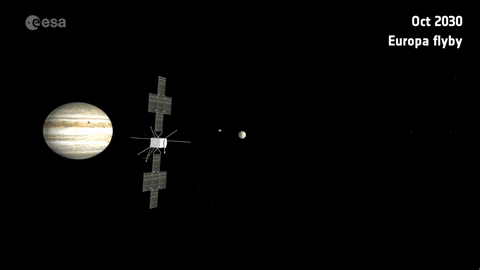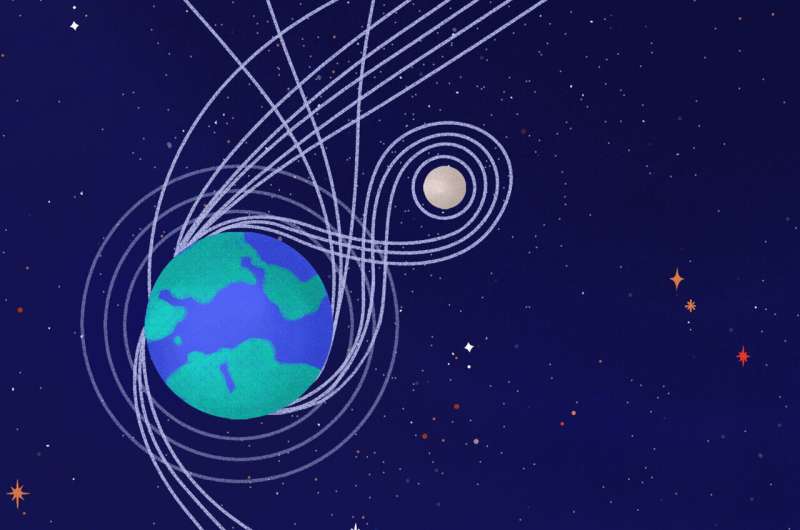Based on this, ESA's flight dynamics experts design a route. The world of orbital mechanics is a counterintuitive place, but with a bit of patience and a lot of planning it allows us to do a great deal of science with just a little fuel, as we'll explain.
Track the motion of planets and moons and stars and galaxies, and you'll see they're always in motion around another object. When a mission launches, it doesn't leap from a still Earth but off a planet zooming at about 30 km/s around the sun.
As such, a spacecraft launched from Earth already has a great deal of "orbital energy"—the only unit that matters when determining the size of an orbit around a central body. Just after launch, a spacecraft is in more or less the same orbit as our planet is around the sun.
To break free from this orbit and fly in the shortest possible straight line from Earth to Jupiter, would need a big rocket and a lot of fuel. But it can be done. The next problem is, you'd then need even more fuel to brake and go into orbit around Jupiter and not zip right past it.
Targeting empty space
Jupiter and Earth are always moving with respect to each other. At their farthest apart, on opposite sides of the sun, they are separated by 968 million kilometers. The shortest distance between the two planets is when Earth and Jupiter are on the same side of the sun with just under 600 million kilometers between them. But they're in this position just for a moment before the distance grows again, never remaining at a constant distance.
The planets are all moving at different rates in their orbits around the sun. Imagine throwing a ball at a moving target from a moving vehicle. Engineers must calculate the ideal time to make the jump on a circular path from Earth's orbit to where Jupiter will be when the spacecraft arrives, not where it is when the spacecraft leaves Earth.
So, assuming we have the most powerful launcher available, and we launch on the shortest trajectory at the right time when the planets are aligned correctly, how long would it take?
Early space missions, such as the Voyager and Pioneer probes, made the journey in less than two years, and the fastest any object has traveled to Jupiter was the New Horizons mission. Launched on 19 January 2006, New Horizons made its closest approach to Jupiter on 28 February 2007, taking a little over a year to reach the planet. All these missions continued onwards, excellent examples to determine how long it takes for a Jupiter flyby on the way to somewhere else.
The longer the stay, the slower the approach
To get into orbit around the huge planet to study it from all sides and over time, perhaps even get into orbit around one of its moons—a Juice "first"—you'll need to lose some energy. This "deceleration" will require a lot of fuel for a large orbit insertion maneuver. If you don't want to launch with vast amounts of fuel, you take the scenic route, with a transfer duration of 2.5 years.
This is where we see the mass of the spacecraft as a crucial factor in determining the time it takes to get anywhere. Engineers need to control the spacecraft's mass, balancing the amount of fuel with the instruments it needs to carry to complete its mission. The more mass the spacecraft has, the more fuel it needs to carry, which increases its weight and makes it more difficult to launch.
And this is where the launching rocket's performance comes in. The spacecraft needs to be launched with sufficient velocity to escape Earth's gravity and be flung on its way to the outer solar system. The better the shove, the easier the trip.
Juice is one of the heaviest interplanetary probes ever launched, at just over 6,000 kg, with the largest suite of scientific instruments ever flown to Jupiter. Even the massive boost from the Ariane 5 heavy-lift rocket wasn't enough to send Juice directly there in a couple of years.
Therefore, missions such as Juice and Europa Clipper, or like Galileo and Juno in the past, have to make use of "gravity-assist" or "flyby" maneuvers to pick up extra speed. The more powerful the rocket, the shorter the transfer.
Trading energy with the solar system
Pluto, at the edge of the solar system, travels in a much larger orbit than Mercury, the innermost planet. Although Pluto moves more slowly with respect to the sun, its orbital energy is far, far greater than Mercury's.
To get a spacecraft into orbit around another planet, we must match its orbital energy. When BepiColombo was launched, its orbital energy was the same as Earth's. It had to lose energy to fall closer to the center of the solar system and did so by shedding excess orbital energy by flying close to neighboring planets.
The same works in reverse to voyage to the outer solar system. To get into a larger orbit, farther from the sun, Juice is on a path that will let it steal orbital energy from Earth, Venus and Mars.

Depending on the relative direction of motion of the planet and the spacecraft, a gravity assist can either speed up, slow down or change the direction of the mission. (The spacecraft also deflects the planet, but by such a miniscule amount as to be insignificant. Nonetheless, Newton's third law of motion has been preserved: "To every action there is an equal and opposite reaction.")
Juice will use series of flybys of Earth, the Earth-moon system and Venus to set it on course for its July 2031 rendezvous in the Jovian system.
Orbit on a knife edge
The most challenging part for the ESA's flight control team comes when Juice finally arrives at Jupiter in 2031 and during its tour of Jupiter's planetary system.
Juice's challenging trajectory involves multiple gravity assists on the way to Jupiter—including the first ever Lunar-Earth flyby—and, once there, an impressive 35 flybys of its Galilean moons Europa, Ganymede and Callisto. The final focus will be on Ganymede, making Juice the first spacecraft ever to orbit a moon other than our own.
The single most important maneuver that teams at ESA's mission control in Germany will oversee, will be the slowing down of Juice by about 1 km/s only 13 hours after a Ganymede gravity assist, and "taking the exit" to enter the Jupiter system, inserting the spacecraft into orbit around the gas giant.
Getting into orbit around another celestial body is hard. A spacecraft must approach with the perfect speed, from a precise angle, then execute a vital, big maneuver at just the right moment, in a specific direction and of the correct size.
Approaching too fast or slow, too shallow or steep, or maneuvering at the wrong time, with the wrong amount or direction and you're lost in space. Or you're far enough off track that it will take a lot—perhaps too much—fuel to correct your path.
Juice will get close to Jupiter's moons, trading energy with them that they've held onto for billions of years, to get a view of these environments like never before. Could there be life under the frozen oceans of Ganymede, Callisto or Europa? What can we learn about the formation of planets and moons throughout the universe? Through the wonder of flight dynamics, by trading energy with the universe, we will soon(ish) find out.
Provided by European Space Agency



